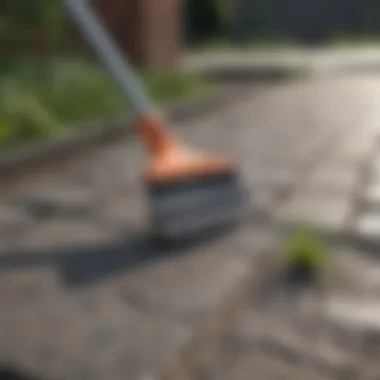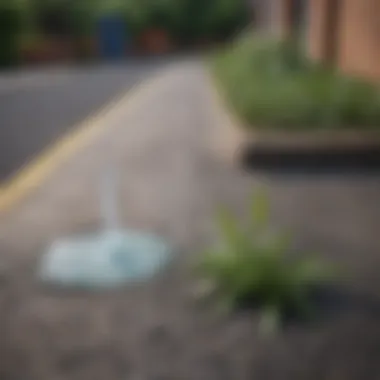Effective Techniques for Weeding Paved Surfaces


Intro
Weeds are persistent challenges in maintaining the beauty and functionality of paved areas. Stone and brick pathways offer a solid structure, yet they can quickly become undermined by unwelcome plant growth. The aesthetic quality and practical use of these outdoor spaces depend on regular maintenance. Consequently, understanding methods to effectively remove and manage weeds is crucial for homeowners who wish to preserve the integrity of their walkways.
This guide intends to provide insights into various removal techniques, with special attention to preventive measures. By exploring both manual and chemical methods, as well as long-term strategies for weed control, this resource delivers a comprehensive overview suited to a range of experience levels.
Key Insights and Trends
The process of removing weeds from paving goes beyond mere aesthetics. It involves understanding the changing dynamics within landscaping and outdoor maintenance.
Current Techniques in Weed Management
In recent years, sustainable gardening practices have grown in popularity. Homeowners increasingly favor organic methods over chemical treatments. This shift reflects a broader trend towards environmental consciousness, where the focus is on minimizing ecological impact.
Additionally, homeowners are now more inclined to invest in durable materials that complicate weed growth. For example, permeable paving allows for better drainage while reducing weed establishment.
Popular Gardening Techniques for Pathway Care
Adopting the following practices can enhance the appearance of paved areas:
- Mulching: Using organic or synthetic mulch around paths can suppress weed growth while adding visual appeal.
- Regular Maintenance: Routine inspections help spot and address weed issues early.
- Plant Selection: Integrating native plants around paved areas can create a self-sustaining ecosystem that naturally limits invasive growth.
Practical Tips and How-To Guides
Effective weed removal is not a one-time effort but requires ongoing attention. Below are step-by-step approaches to managing weed presence in paved areas.
Manual Removal Techniques
- Identify Weeds: Learn to distinguish between desirable plants and weeds.
- Use Hand Tools: Employ tools like weeding forks or hoes for manual extraction. These help get to the root of the weed, reducing the chance of regrowth.
- Timing is Key: Morning is the best time to weed. Soil is moist, making removal easier.
Chemical Solutions
In certain conditions, chemical herbicides can effectively control weed populations. Choose formulations that qualify as selective herbicides to minimize harm to surrounding plants and the environment. Always adhere to the manufacturer’s instructions.
Long-Term Management Strategies
Maintaining weed-free paving is an ongoing process. Consider implementing the following:
- Regular Cleaning: Keep pathways clear of debris. This reduces the chance for weeds to take hold.
- Soil Improvement: Healthy soil encourages desired plant growth while often suppressing weeds.
- Covering Gaps: Filling gaps with sand, gravel, or joint stabilizers can prevent weed seeds from settling.
Effective weed management enhances the visual appeal and longevity of paved surfaces, ensuring they remain an inviting aspect of outdoor spaces.
With the right blend of manual and chemical approaches, along with sound practices for long-term maintenance, homeowners can achieve pristine and weed-free paths. This comprehensive guide paves the way for anyone committed to nurturing the beauty of their outdoor environment.
Understanding the Weed Issue
Weeds are more than just unsightly nuisances in paved areas; they can profoundly affect both appearance and function. Understanding the weed issue is crucial to effectively address it. Without awareness of how invasive plants emerge and grow, interventions become random and often ineffective.
One must consider the way weeds adapt to their environment. They exploit any available space, rapidly spreading through cracks and joints in paving materials. This aggressiveness necessitates that homeowners and gardeners remain vigilant.
Definition of Paving Weeds
Paving weeds refer to unwanted plants that grow on or between stones, bricks, or concrete in outdoor spaces. They typically have robust roots that can penetrate paving materials, making removal challenging. Common examples include dandelions, crabgrass, and moss. These weeds thrive in conditions created by human activity, such as poor drainage and compacted soil.
Common Types of Weeds Found in Paved Areas
The types of weeds that show up in paved areas vary based on location and conditions, but several are particularly notorious:
- Dandelions: Characterized by bright yellow flowers, these weeds have deep taproots. They can destabilize paving.
- Crabgrass: This annual weed tends to spread quickly, often appearing in warm weather.
- Creeping Charlie: A perennial that spreads through creeping stems, it can blanket areas and obscure desirable plants.


Understanding the identity of these weeds is essential for proper management.
Impact of Weeds on Paving Integrity
Weeds can have a significant adverse effect on the integrity of paved surfaces. As their roots grow, they expand and can cause cracks, lifting stones or bricks over time. This not only affects aesthetics but can lead to more serious structural issues.
"Weeds often hide potential issues beneath the surface, quietly compromising the longevity of our outdoor investments."
Moreover, these invasive plants can obstruct proper drainage, creating conditions that foster further weed growth and even mold. This cycle can result in increased maintenance costs and safety hazards, as uneven surfaces pose risks for slips and falls.
Overall, grasping these facets of the weed issue lays the groundwork for effective strategies to mitigate their impact. Helping property owners maintain their outdoor spaces is a vital goal.
Assessment of the Paved Area
Assessing the paved area is the crucial first step in tackling weed problems effectively. It enables homeowners to pinpoint specific issues and develop targeted solutions for their outdoor spaces. Understanding the existing conditions helps in selecting the best removal method. Additionally, evaluating the paving area provides insights into the extent of weed infestation, which is vital for both immediate action and long-term management.
Identifying problematic areas also includes recognizing the characteristics of the weeds themselves. Some may be invasive, raising the urgency for immediate action, while others may require a different approach. Having a clear grasp of where the issues lie allows for a more structured and efficient weeding strategy. This assessment can save time and resources over the long haul.
Identifying Problematic Areas
Identifying problematic areas within your paved surfaces is essential for effective weed management. Generally, these areas are where weeds thrive, often due to specific conditions that encourage their growth. Common factors include poor drainage, soil left behind from construction, or gaps between paving stones.
- Examine gaps and joints: Weeds frequently emerge from the joints and cracks between stones. Inspect these spaces closely.
- Look for shaded areas: Some plants prefer shade, making them likely to grow in the nooks of shady pavements.
- Assess moisture levels: Excess moisture can create a conducive environment for weeds. Areas that collect rainwater can be hotspots for weed growth.
In these steps, it helps to keep a record of observations. A detailed account of these conditions can guide any corrective measures needed later.
Understanding the Paving Material
Understanding the paving material is a key element of effective weed management. Different materials respond to weed removal techniques in varied ways. For example, stone pavements may have features that prevent weed growth better than brick surfaces. Thus, knowing the material can lead to more tailored strategies.
- Types of paving materials: Common materials include concrete, stone, and bricks. Each has its characteristics and requires unique approaches to weeding.
- Maintenance level: Some materials may need regular sealing or maintenance to prevent weed infiltration.
- Durability: Understanding how durable your paving is can influence whether to use chemical treatments or manual removal.
Evaluating the composition of your paving will not only aid in current weed management but also assist in future maintenance decisions and potential upgrades.
Manual Weeding Techniques
Manual weeding techniques play a critical role in maintaining the integrity of paved areas. Unlike chemical solutions, which may have side effects, manual methods provide an environmentally friendly option. Homeowners can control specific weeding efforts, avoiding harm to surrounding plants and wildlife. Not only does this approach foster a deeper connection with the outdoor space, but it also allows for immediate assessment of the condition of the paving and underlying soil.
The Right Tools for Manual Weeding
Using the right tools is essential to successful manual weeding. Tools such as hand trowels, hoes, and cultivators enable effective weed removal with minimal disruption to the surrounding soil. Each tool serves a unique purpose, contributing to a more efficient weeding process. For instance, a hand trowel is particularly adept at getting into tight spaces around bricks or stones. Additionally, a hoe can make it easier to remove larger patches of weeds in wide-open areas.
Effective Manual Weeding Methods
-#### Pulling by Hand
Pulling weeds by hand is one of the most straightforward methods of manual weeding. This method is particularly effective for small patches or individual weeds. The key characteristic of pulling by hand is direct contact with the weed, allowing for precise removal. One of its significant advantages is that it enables the identification of different weed species and their growth behaviors, contributing to a nuanced understanding of the weed issue at hand. However, it requires physical effort and may lead to stress on the back if done improperly.
-#### Using a Weeding Tool
A weeding tool is beneficial for homeowners who want to efficiently extract weeds without excessive labor. The primary feature of these tools is their ergonomic design, which minimizes strain on the user. Using a weeding tool can significantly decrease the time spent compared to manual pulling alone. A key disadvantage might be the initial learning curve in using these tools correctly. Improper usage can lead to breaking off the weed at the surface, allowing regrowth.
-#### Removing Roots
Removing the roots of weeds is essential for long-term efficacy in weed control. Ensuring that the root system is wholly disengaged prevents weeds from returning. This method contributes to the overall goal of creating a weed-free environment by disrupting the lifecycle of these pests. The unique aspect of removing roots is that it often requires a combination of tools and physical effort, making it a more labor-intensive method. Nevertheless, it provides a level of satisfaction for homeowners who recognize the complete removal of unwanted plants.
Timing and Conditions for Manual Weeding
The timing and conditions for manual weeding are crucial for success. It is best to weed when the soil is moist, as this makes it easier to pull out weeds with roots intact. Early morning or late afternoon can offer the right conditions, as the sun is less intense. Additionally, hand-pulling weeds when they are small increases the likelihood of effective removal before they develop extensive root systems. > "Timing is everything in weed management; choose wisely to maximize your efforts."
Chemical Weeding Solutions
Chemical weeding solutions play an important role in maintaining paved areas. The right herbicides can target persistent weeds without causing significant harm to surrounding plants or the environment. Understanding how to effectively utilize these solutions helps homeowners and gardening enthusiasts achieve a clean and well-kept outdoor space. While manual methods of weeding have their place, there are times when chemical solutions are quicker and more efficient, especially for large infestations.
Overview of Chemical Herbicides
Chemical herbicides are specially formulated substances designed to kill or inhibit the growth of unwanted plants. These products vary in their active ingredients and modes of action. Some herbicides are selective, meaning they target specific types of plants while leaving others unharmed. Others are non-selective, killing any plant they come in contact with.
Different categories include:
- Pre-emergent herbicides: Applied to prevent weed seeds from germinating.
- Post-emergent herbicides: Used on mature weeds that are already growing.
- Systemic herbicides: Absorbed by the plant and translocate throughout its tissues, effectively killing it from the roots up.


Knowing which type to use based on the problem can greatly increase the effectiveness of weed control efforts.
Choosing the Right Herbicide
Selecting the appropriate herbicide necessitates careful consideration of several factors. First, identify the type of weeds you are dealing with. This ensures that the chosen herbicide is effective against those specific species. Additionally, consider the surrounding vegetation. If desired plants are nearby, a selective herbicide is usually more suitable.
Second, evaluate the environmental conditions. Different herbicides work best under specific weather conditions and temperature ranges. Always read and adhere to the product's labels, as they provide crucial information on safe usage and application. Finally, take into account any potential impacts on local wildlife and water sources, especially if you live in a sensitive ecological area.
Application Methods for Herbicides
Applying herbicides requires attention to detail in order to maximize effectiveness and minimize risks. Here are some recommended methods:
- Spray Application: This is the most common method. Use a garden sprayer or a backpack sprayer to apply herbicides evenly across problem areas. Ensure to maintain the correct distance to prevent drift onto desirable plants.
- Drenching: For targeted weed roots, drenching involves pouring the herbicide solution directly onto the soil around the plant. This method minimizes the impact on nearby flora.
- Granular Application: Some herbicides come in granular form, which can be spread over the surface. This method is often used for pre-emergent herbicides to create a barrier that prevents seeds from germinating.
- Foam Applications: Certain herbicides may be available in foam form for direct application to specific plants.
Regardless of the method chosen, always follow the manufacturer's instructions regarding dilution, timing, and safety precautions.
"Understanding the appropriate use of chemical herbicides can optimize weed control efforts while safeguarding surrounding plants and the ecosystem."
Preventive Measures Against Weeds
Preventive measures are crucial for maintaining the integrity and appearance of paved areas. Ignoring early signs of weed growth can lead to more extensive infestations that threaten both aesthetic and structural features. Being proactive helps avoid the need for extensive remediation later. Here are some essential strategies, each with its specific merits.
Use of Landscape Fabric
Landscape fabric serves as a barrier that prevents weed seeds from germinating while still allowing for air and water circulation. It is typically made of durable polypropylene fibers and can be laid down before planting or installing paving stones. The significance of landscape fabric lies in its ability to suppress weeds effectively, thereby minimizing the ongoing maintenance needed. Proper installation involves rolling out the fabric over the desired area, anchoring it down with stakes, and overlapping seams to ensure no gaps are present. Its long-term use can significantly contribute to a healthier paved space.
Implementing Proper Drainage
Effective drainage is an often-overlooked aspect that plays an integral role in weed prevention. When water accumulates in paved areas, it creates a suitable environment for weed growth. By ensuring that water flows away from paving, you limit the ability of weeds to establish themselves. This can be achieved through grading, installing drains, or utilizing permeable paving materials. Proper drainage reduces standing water, thus diminishing weed seeds' chances for germination and growth. Planning drainage solutions should be tailored to the specific conditions of your garden or paved area.
Regular Maintenance Practices
Regular maintenance practices cannot be understated in the realm of weed prevention. Simple tasks like on-schedule inspections of paved areas can help identify problems before they escalate. Regularly clearing debris minimizes the available organic matter that could support weed growth. Additionally, routine cleaning of paved surfaces, whether by sweeping, hosing down, or pressure washing, can disrupt the weed lifecycle.
To ensure optimal outcomes, consider establishing a seasonal maintenance schedule. This should include:
- Monthly inspections: Check for new weed growth or vulnerabilities.
- Debris removal: Clear leaves, soil, and other organic materials.
- Cleaning: Maintain the surface through brushing or washing.
- Adjusting drainage: Adjust any measures that may not be functioning well.
By implementing these preventive measures, you equip yourself to handle the ongoing challenge of weed management. Investing time upfront in these practices saves both effort and resources in the long run. > **
Long-Term Weed Management Strategies
Maintaining the aesthetics of paved areas extends beyond initial removal of weeds. Long-term weed management strategies ensure that pathways remain free from unwanted vegetation over time. These strategies are vital for homeowners seeking a balance between a beautiful outdoor space and a structurally sound surface. Implementing these methods effectively reduces the recurrence of weeds and minimizes future maintenance efforts.
Integrated Pest Management Approaches
Integrated Pest Management (IPM) encompasses various tactics aimed at controlling weed populations while being environmentally conscious. This approach emphasizes the integration of several techniques, which can be categorized into cultural, mechanical, biological, and chemical methods. Such a comprehensive strategy encourages homeowners to be proactive rather than reactive.
- Cultural Methods: These involve practices such as selecting appropriate paving materials and maintaining healthy soil conditions. By ensuring that the surrounding environment is not conducive to weed growth, homeowners can significantly reduce weed emergence.
- Mechanical Methods: Regular mowing, hoeing, or using specialized tools can physically remove weeds before they set seed. This manual labor is effective particularly during early seasonal growth points.
- Biological Control: This includes introducing natural weed predators or competitors that can naturally suppress weed populations. For instance, ground cover plants can outcompete weeds for space and nutrients.
- Chemical Methods: While IPM prefers non-chemical solutions, judicious use of selective herbicides might still be necessary. Choosing products that target specific weed species reduces harm to desirable plants.
IPM offers a balanced route to long-term management. It not only reduces reliance on harsh chemicals but also encourages a healthier ecosystem.
Advantages of Mulching
Mulching plays a pivotal role in the long-term strategy for weed control. A proper layer of mulch can provide several advantages:
- Suppressing Weeds: Mulch blocks sunlight, inhibiting weed seed germination. This is particularly effective in preventing persistent perennial weeds.
- Moisture Retention: A mulch layer helps retain soil moisture, which benefits growth of desirable plants. This can reduce the need for frequent watering and maintain a healthier landscape.
- Stabilizing Soil Temperature: Mulch can moderate soil temperature fluctuations, creating a more stable environment for plants.
- Enhancing Aesthetic Appeal: With various materials available, such as wood chips or decorative stones, mulch can improve the overall look of your paved area.
- Nutrient Supply: Organic mulch decomposes over time, enriching the soil with essential nutrients for your plants.
Incorporating mulch into the landscape design is both a practical and aesthetic solution to manage weeds effectively over the long term.
"Long-term strategies are essential in creating a sustainable and thriving outdoor environment."


Employing these long-term weed management strategies will not only improve the appearance of paved surfaces but also contribute to a well-maintained and resilient outdoor space.
Impact of Weather on Weed Growth
Understanding how weather influences weed growth is vital for effective weed management in paved areas. Weather conditions dictate the development and lifecycle of plants, including weeds. Factors such as temperature, rainfall, and sunlight directly affect weed germination, growth rates, and persistence.
Seasonal Changes and Their Effects
Each season brings unique challenges and opportunities for weed control.
- Spring: This season typically provides ideal conditions for weed growth. Warmer temperatures and increased moisture levels allow many weeds to thrive. Homeowners should be proactive during this time by implementing early weeding practices.
- Summer: Prolonged heat and arid conditions can hinder some weed types. However, warm-weather weeds like crabgrass often flourish, so regular monitoring is necessary.
- Autumn: The drop in temperature leads to changes in weed behaviors. Some perennial weeds start to die back, while others produce seeds for future growth.
- Winter: Many weeds become dormant but can still pose problems in early spring, as early germinators may sprout ahead of desired plants.
Tracking these seasonal patterns helps homeowners develop well-timed interventions to mitigate weed infestation.
Climate Considerations for Different Regions
Factors such as regional climate significantly influence weed types and their growth patterns.
- Temperate Climates: Get moderate levels of rainfall and temperature. Weeds common in these areas include dandelion and chickweed. Management must focus on both summer and fall suppressions.
- Arid Climates: Areas with low rainfall need to address drought-resistant weeds like purslane. Depending on water availability, regular weeding may become crucial to prevent weed establishment.
- Tropical Climates: These regions experience high humidity and temperature, promoting a variety of weed species. Understanding local ecosystems can aid in employing effective control methods.
Each climate presents its own set of challenges and requires targeted approaches to effectively manage weeds. Awareness of weather influences assists homeowners in choosing the best strategies to maintain their paved spaces devoid of unwanted vegetation.
Safeguarding Paving After Weeding
After successfully removing weeds from paved areas, it is crucial to consider how to safeguard the paving. This step is often overlooked but is vital to maintain the integrity and appearance of the outdoor surfaces. Weeds, if left unchecked, can create long-standing damage. Thus, protecting paving should be a priority for homeowners.
Repairing Damage from Weeds
Weeds can cause significant harm to paved surfaces over time. Their roots may seep into cracks, potentially widening them and causing structural issues. Repairing any damage should be the first action. Small cracks can be filled with appropriate filler solutions. A mixture of sand and polymer-modified mortar works effectively.
To repair larger cracks, it may be necessary to remove the damaged area. Resetting stones or bricks can restore the original surface. For those who prefer more advanced solutions, consulting a paving expert might ensure a long-lasting repair.
Sealing and Protecting Paved Surfaces
Once the weeding and repairs are complete, sealing the paved surfaces is the next step. Sealing provides a protective layer that prevents weeds from regrowing and reduces the likelihood of future damage. There are various sealants available, such as acrylics and polyurethanes.
Choosing the right sealant depends on the paving material. It is essential to follow the manufacturer’s instructions on application, as improper sealing can lead to peeling or yellowing.
Benefits of sealing include:
- Increased resistance to water infiltration.
- Protection against UV rays.
- Improved aesthetics through enhanced color.
"A well-maintained paved surface speaks volumes about the care taken in outdoor spaces."
For further reading and tips, visit Wikipedia on landscaping or check discussions on Reddit related to gardening techniques.
Ending and Final Thoughts
The topic of weed removal from paving is vital for several reasons. It addresses not only aesthetic but also structural concerns related to outdoor spaces. Well-maintained paving enhances property value and creates a visually pleasing environment. Moreover, understanding and implementing effective weed management strategies can significantly reduce maintenance efforts in the long run.
This article has presented a thorough exploration of various methods to eliminate weeds from paved areas. By assessing the problem areas and selecting appropriate techniques, homeowners can effectively combat this persistent issue.
Ultimately, regular maintenance and vigilance are necessary to ensure paved surfaces remain weed-free. Homeowners must adopt a consistent and informed approach, whether through manual techniques or chemical solutions.
"A proactive strategy is key to preserving the integrity and beauty of your paved outdoor spaces."
Recap of Key Points
- Weeds compromise the visual appeal and stability of paved areas.
- Various methods exist for weed removal, including manual and chemical options.
- Preventive measures can greatly minimize the occurrence of weeds by managing conditions that favor their growth.
- Long-term strategies, such as integrated pest management, enhance the overall effectiveness of weed control.
- Ongoing maintenance is crucial to sustain a weed-free environment.
Encouragement for Ongoing Maintenance
Regular upkeep is essential for maintaining the integrity of paved surfaces. Set a schedule for inspecting paved areas, ensuring that any weed activity is addressed promptly. Simple steps, such as seasonal cleaning and soil treatment, can make a significant difference. By being proactive, homeowners can create a more pleasurable outdoor experience.
In addition, consider engaging with local gardening groups on platforms like Reddit or Facebook. These forums can provide valuable insights and foster a community dedicated to effective weed management. Always remember that a little effort consistently applied goes a long way in keeping your outdoor spaces pristine.
Taking charge of weed control not only preserves your investment but also enhances the beauty of your home. Engage in mindful practices, and your paved areas will endure the test of time.



